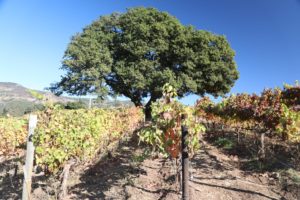
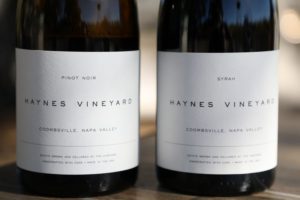
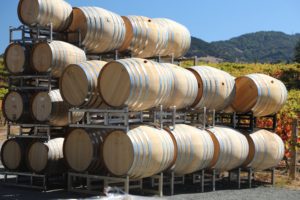 Haynes Vineyard. While there are older vineyards in Coombsville still commercially producing, the Haynes Vineyard, not to be confused with the also historic Hayne Vineyard in St. Helena, is probably the most well-known vineyard in the appellation. The property was under the same family ownership from 1885 until 2019 when it was acquired by Gaylon Lawrence, only it’s third owner.
Haynes Vineyard. While there are older vineyards in Coombsville still commercially producing, the Haynes Vineyard, not to be confused with the also historic Hayne Vineyard in St. Helena, is probably the most well-known vineyard in the appellation. The property was under the same family ownership from 1885 until 2019 when it was acquired by Gaylon Lawrence, only it’s third owner.
Duncan (died in 2007) and Patricia (Porter) Haynes (both UC Berkeley graduates) managed the property for several decades. Duncan’s great uncle, James Whitford through his mother’s side of the family purchased the property from the founder of the city of Napa, Nathan Coombs in 1885 for $3,135 in gold coins. Several articles from local newspapers make reference to this transaction including the March 27, 1885 issue of the Napa County Reporter which detailed the transaction as 33.36 acres. During early visits to the property, we used to see a copy of the original deed of sale displayed inside the winery.
A year after his initial acquisition, in 1886 Whitford purchased exactly 10 more acres from a Dennis O’Brien for a total parcel size of 43.36 acres as mentioned under real estate transactions in the November 18, 1886 issue of the Napa Weekly Journal. The November 20, 1891 issue of The Napa Register mentions that James Whitford transferred 43.36 acres to Jane Whitford and Thos (Thomas) Jacka for love and affection.
Over the years, the property was used for cattle grazing, was a prune orchard and was also planted to a number of other fruit trees. Duncan used to visit in the summer and spent his teenage years helping pick prunes from the property.
According to Duncan Haynes in a Napa Valley Register article dated April 5, 1992, the Haynes Vineyard was originally planted to 20 acres of Chardonnay and Pinot Noir in 1967. The same article indicates that after the success of their first vines they later planted another 18 acres in the early 1970s. Duncan’s mother Irene (whose husband Evan passed in 1955) was partially responsible for the decision to plant wine grapes during those years. In 1980 she authored and photographed Ghost Wineries of Napa Valley, a short black and white book highlighting numerous primarily stone wineries built before Prohibition. It has long been on our list to publish an updated color version of this book as there have been many changes since Irene published her book. This was not the first book that Irene contributed to; in 1962 her photographs were included in a book called Bonsai, Dwarfing Trees in the Modern Manner by Glady’s Aske. She is also credited by Kay Archuleta for helping inspire and aiding in the efforts of Kay’s book, Early Calistoga, The Brannan Saga. And for part of the 1970s she was the staff photographer for the Napa Valley Wine Library.
Winemaker André Tchelistcheff (of Beaulieu Vineyard) walked the property and provided vineyard consultation as did Louis M. Martini. André also helped design the winery on the property (dates from the early 1980s) and is where the Haynes wines are produced. Three acres of the oldest Chardonnay vines are still growing as are 2 acres of the original Pinot Noir. These are most likely the oldest plantings of these varieties in Napa Valley – for reference other old Chardonnay vines in Napa Valley date from 1968 at School House Vineyard on Spring Mountain. And they are some of the oldest vines of both varieties in the state of California still being used for making commercial wine. Reference Hanzell Vineyards in neighboring Sonoma County for the oldest vines of both Chardonnay and Pinot Noir in the state (dating from 1953).
The Pinot Noir was sourced from cuttings from the Three Palms Vineyard in Calistoga from vines originally growing in Burgundy. This iconic vineyard was planted to Pinot Noir in its early days but is now known for its exceptional Merlot. This particular Pinot Noir is known as the Martini clone. Louis Martini Winery purchased all of the vineyard’s Pinot Noir grapes for the first few years of their production. The old Chardonnay is a Wente selection. Both these old Chardonnay and Pinot Noir vines are growing on St. George rootstock.
Ducan and Pat founded Whitford Cellars in 1983 with an initial focus on producing Chardonnay from the property. Their first vintage was 500 cases of Chardonnay; they later produced Pinot Noir and Syrah. André Tchelistcheff and Chuck Ortman were their consulting enologists. Former vineyard manager Fernando Delgado was an integral part of the Haynes Vineyard for nearly 50 years. He began tending the vines in 1970, lived on the property and more recently, retired to Mexico.Coombsville is a fairly cool region with its temperatures strongly moderated by the nearby San Pablo Bay. And the Haynes Vineyard is located in one of the cooler parts of Coombsville. During Duncan & Pat Haynes ownership, they tried to grow Cabernet Sauvignon here but ultimately found it was too cold for this variety. What is interesting to note is that some of their nearby neighbors were successfully growing Cabernet Sauvignon at the time. Despite the close proximity, those properties are significantly warmer than the Haynes Vineyard. However as temperatures have warmed over the years, the Haynes Vineyard is now planted to a small amount of Cabernet Sauvignon.
The Haynes Vineyard property is at an elevation of about 150 feet above sea level and is 43 acres of which 33 acres are planted to vines. Chardonnay comprises at least 50% of the plantings along with Pinot Noir and smaller sections of Cabernet Sauvignon, Mourvèdre, Syrah and an extremely rare planting of Mondeuse in Napa Valley. The only other site we know of with this variety in Napa Valley is the Lagier Meredith Vineyard on Mt. Veeder. The soils are composed of diatomaceous earth and volcanic rock including tufa. The vineyard lies within a collapsed caldera of an ancient volcano. While walking the vineyard one can easily see the surrounding hills lying in roughly a semi-circle in the near distance forming the edges of the caldera. And an image of the giant oak tree which grows roughly in the middle of the vineyard is used on their Corazon bottlings.
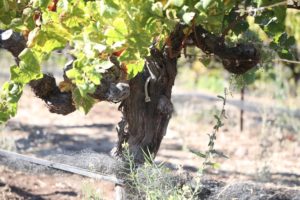
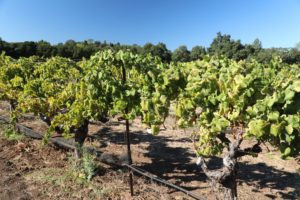 Over the decades grapes from the property have been sold to a number of premium producers including Ancien, Arnot Roberts, Beaulieu Vineyard, Enfield Wine Co., Failla, Stag’s Leap Wine Cellars and Tulocay among others. Following Laurence’s acquisition of the property, no commercial wines were produced from the 2019 vintage. Their inaugural vintage was from 2020. And as of 2023 grapes from Haynes Vineyard are no longer being sold to other producers.
Over the decades grapes from the property have been sold to a number of premium producers including Ancien, Arnot Roberts, Beaulieu Vineyard, Enfield Wine Co., Failla, Stag’s Leap Wine Cellars and Tulocay among others. Following Laurence’s acquisition of the property, no commercial wines were produced from the 2019 vintage. Their inaugural vintage was from 2020. And as of 2023 grapes from Haynes Vineyard are no longer being sold to other producers.
The Haynes wines are bottled as three tiers; Vigneron referring to the estate wines or what they grow, Forgeron are wines produced from the oldest vines on the property and are what they craft, and Corazon are extremely limited production wines from a selection of the best producing vines each vintage and refer to what they love. As of our latest update to this review, five wines are bottled from Haynes Vineyard including three Chardonnays, one Pinot Noir and a Syrah.
The winemaking for each of the three Chardonnay bottlings is very similar including adding no sulfites until just prior to bottling. Fermentation times dramatically vary depending on the vintage. In 2021, primary fermentation took 18 months – the majority of that time for a small percentage of residual sugar to slowly be converted into alcohol. These wines are aged up to 24 months in 500L to 2000L oak vessels crafted by Austria based Stockinger and then up to a year in bottle before being released. And unlike most wineries who release their white wines before their reds, the release schedule here is the opposite. The Pinot Noir and Syrah are typically aged for about 11 months in barrel.
It is crystal clear from the first aromas to the first taste of of the Haynes Vineyard bottlings that they are not making ripe, fruit forward and opulent Napa Valley wines. Rather they are producing energetic wines of character but also with finesse and freshness supported by a strong sense of place.
And Duncan Haynes would certainly be proud of these wines; in a Napa Valley Register article dated April 5, 1992 he is quoted as saying, “We try to emphasize the varietal character of the grape, rather than the oak of the malolactic fermentation characteristics that are part of the winemaking process. We don’t want to be lumped in with others, to be labeled just another good Chardonnay”.
Select wines
The 2020 Haynes Vineyard Vigneron Chardonnay was sourced from primarily the younger vines on the property but also includes grapes from the late 1960s plantings. This wine is medium golden in color; the bouquet offers a minerally character, citrus blossom, an herbal note, honeydew melon, vanilla, wet straw, under ripe pineapple and a lemon zest. The brightness on the bouquet is echoed on the palate with flavors of passion fruit, pomelo and kiwi. The supple texture is balanced nicely by its acidity. In a blind tasting against California Chardonnays crafted in a heavier, richer style with an ample amount of oak, one should be able to easily identify this bottling. The Chardonnay was fermented using indigenous yeast and went through 100% malolactic fermentation. And it is important to note that in a year known for the terrible wildfires in and around Napa Valley, the grapes for this wine were scheduled to be harvested and were not a last minute, “we need to pick now” decision.
Former Haynes Vineyard winemaker Nico Cueva who has worked with numerous Chardonnay vineyards throughout his career calls the Haynes Vineyard the most special site for Chardonnay he has ever worked with. He told us that this vineyard, “produces Chardonnay of intensity, depth and intrigue”.
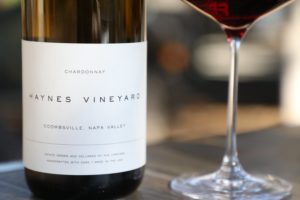
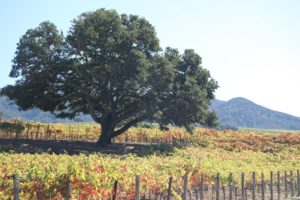 The 2021 Haynes Vineyard Forgeron Pinot Noir is produced from a large percentage of the oldest grape vines on the property. This wine is medium ruby in color; the aromatics are extremely attractive and feature a gorgeous play of spices including cardamom, cloves and tobacco accompanied by a note of green tea leaf and a union of bright fruit including red cherry and raspberry. This wine smells like Pinot Noir. It also tastes like Pinot Noir and that is perhaps the highest complement one can bestow upon a variety where grown in California it is sometimes overly manipulated and masked from its true varietal characteristics. It offers flavors of red cherries, currant, pomegranate, raspberry and red plums. The finish is bursting with a brightness of red fruits paralleled by lightly grainy textured and well-integrated tannins. Mouthwatering, fresh and savory. This wine was fermented 85% whole cluster and aged for 11 months in low oak impact larger vessels. Oak is always a light complementary character in the Haynes wines. Alcohol is only one among many characteristics of wine, nonetheless it is an important component and when its this low (12.21%), we feel obligated to point it out.
The 2021 Haynes Vineyard Forgeron Pinot Noir is produced from a large percentage of the oldest grape vines on the property. This wine is medium ruby in color; the aromatics are extremely attractive and feature a gorgeous play of spices including cardamom, cloves and tobacco accompanied by a note of green tea leaf and a union of bright fruit including red cherry and raspberry. This wine smells like Pinot Noir. It also tastes like Pinot Noir and that is perhaps the highest complement one can bestow upon a variety where grown in California it is sometimes overly manipulated and masked from its true varietal characteristics. It offers flavors of red cherries, currant, pomegranate, raspberry and red plums. The finish is bursting with a brightness of red fruits paralleled by lightly grainy textured and well-integrated tannins. Mouthwatering, fresh and savory. This wine was fermented 85% whole cluster and aged for 11 months in low oak impact larger vessels. Oak is always a light complementary character in the Haynes wines. Alcohol is only one among many characteristics of wine, nonetheless it is an important component and when its this low (12.21%), we feel obligated to point it out.
The 2021 Haynes Vineyard Forgeron Syrah was 100% fermented whole cluster. This wine was sourced from vines planted in 1996 and 2000. It is deep ruby in color; the fresh and lively bouquet offers a beautiful union of both spices, fruit and floral tones. It initially offers aromas of old library book/parchment paper, white pepper, a light herbal character, tobacco and becomes more floral as it evolves in the glass including scents of rose petals and violets. The palate sports flavors of cranberry, currant, sour cherry and red plums. The finish lingers savory, bright and with an herbal freshness along with notes of white pepper, dried herbs and a light but persistent chalky character. The tannins are lightly textured, but noticeable. This is a balanced and refreshing cooler climate Syrah. Its alcohol is 12.57%. Nico told us when he first made this wine from the Hayne Vineyard in 2020, it brought a smile to his face. We can see why.
—
The wines are sold direct through an allocation list with shipments sent twice a year, once in spring and once in fall. Members also receive a copy of the Haynes Almanac, a collection of photographs, drawings and words documenting the changes of the season. A limited number of wines are distributed to select domestic markets and retail spaces. For more information and to request an allocation membership, visit: www.haynesvineyard.com






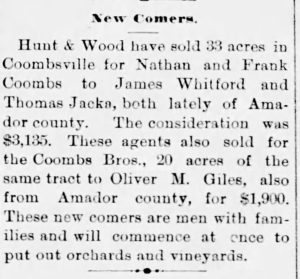
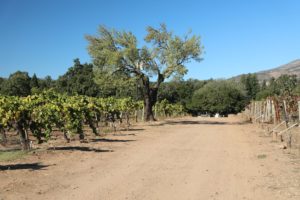
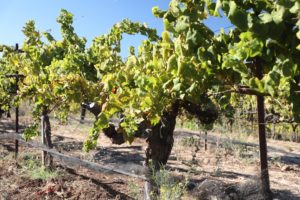
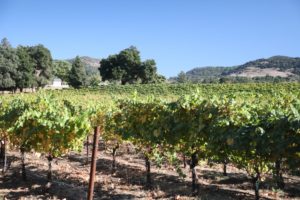
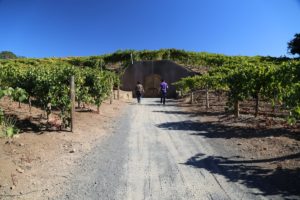
Leave a Reply